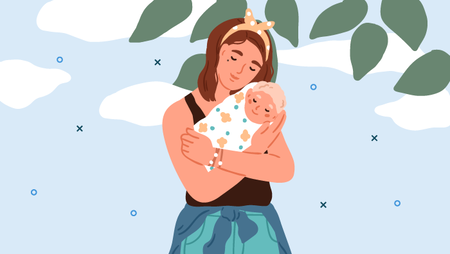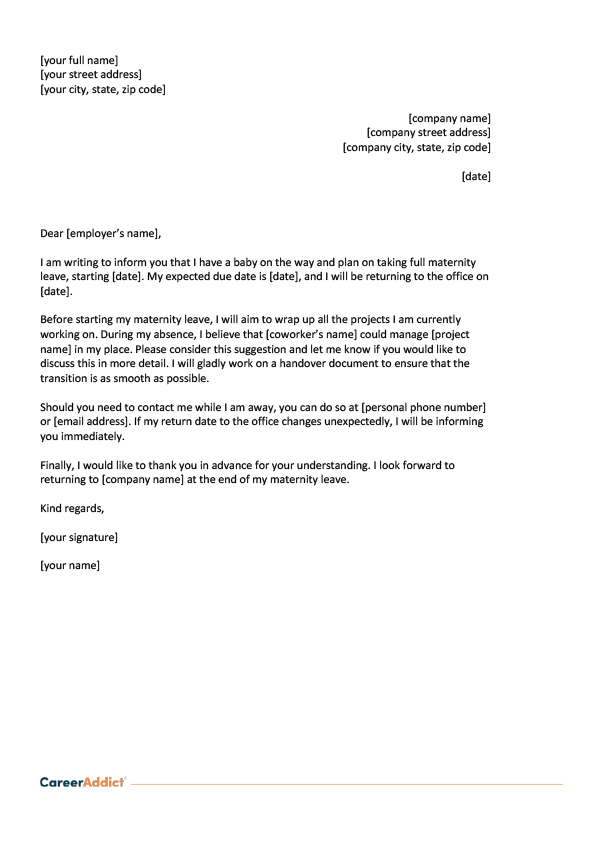
Are you pregnant? Here is how to request maternity leave.

Preparing for the birth of your baby is an exciting but stressful time — especially if it’s your first child. You’ll need to make sure you’re fully prepared for the arrival of your little bean. But first things first, you need to get your time off work approved to ensure you’re covered by your statutory pay while you’re on leave — and have a job to go back to.
Maternity leave will give you the time to recover from childbirth and bond with your little one before you’re thrown back into the real world as a working mom. But in order to get your full maternity allowance, you need to put all the details in writing.
This guide will walk you through the steps to preparing a professional maternity leave letter, with some useful samples.
When it comes to making important requests in the workplace, it’s a good idea to have everything down in writing. If you choose to speak to your boss in person about your upcoming absence, it’s best to follow that up with a letter or email, just to keep a record of the key dates and information you brought forward.
By law, you are not required to let your employer know until later on in the pregnancy. However, consider having this conversation early, at the start of the second trimester, as trying to conceal a pregnancy can be stressful for both you and the baby.
As always, have a look at company policy if you’re unsure about minimum notice requirements.
From cover letters to complaint letters and resignation letters, all written communication you hand in to your employer should follow formal letter structure. Regardless of content, these should include a date, your name and address, your recipient’s name and address, and your signature. Make sure you’ve got all that down in your request for maternal leave.
Aside from that, the letter to your employer should include:
Official requests in the workplace need to be put in writing and formatted correctly. These tips below will help you achieve this in your maternity leave letter writing.
So far, we’ve talked about the benefits of handing in a letter versus informing your employer verbally. We’ve also covered the main points you should include in your letter.
Before you start writing, read through some final, useful tips that can help you achieve a professional tone and ensure your transition from office to home is a smooth one.
Although you’re probably thrilled to have a change of scenery for at least 12 weeks, do not let your employer catch wind. It’s important to stress how you will be looking forward to returning to the office once you’ve settled in at home with your baby.
It can be hard to tell how much time you will need off work after you’ve delivered your baby. With postnatal depression being common among first-time moms, you might not feel up to returning to work just a month after giving birth. As such, it’s best to request the maximum time of absence you’re entitled to; that’s 12 weeks of maternity leave. You can always change this later down the line if you feel ready to return to the office before your entitlement is over.
It’s advisable to hand in your maternity leave letter as soon as you have the all-clear from your midwife that you’re in your pregnancy’s safe period (this is usually after three months have passed). By law, you should tell your employer that you are pregnant no later than 15 weeks before your baby is due.
In addition to your formal letter, if you’re in the UK, you will also need a maternity certificate from your doctor (MAT B1) confirming your pregnancy and your due date. This is usually given after you’ve reached 21 weeks of pregnancy.
This sample letter taken from Sample Resignation Letters can be used for an employee who is planning on taking the full maternity allowance. Of course, it can be tweaked to fit your specific circumstances.
Pregnancies are often unexpected, and a few mothers seem to experience pregnancy difficulties that force them to take their maternity leave sooner than expected. The following email template can help you inform your manager and HR department about these kinds of situations.
Since your letter will serve as official notice to your employer, it must follow the structure of a business letter. And, because we know that these types of letters can be tricky to write, we’ve included the following maternity leave letter template to help you quickly get started.

As a soon-to-be mom, many things will start requiring your full attention. The points below can help you eliminate additional stress, at least where work is concerned.
Final thoughts
Asking for maternity leave can be stressful, especially if you are quite new to the team. However, as a mother and a working woman, you’re entitled to this allowance. By following the right procedure, a huge weight will be lifted off your shoulders, knowing that your leave has been accepted without affecting the future of your career.
Did you find this useful? Share it with your friends so they know how to write a maternity leave letter, too!
Originally published March 21, 2018. Updated by Electra Michaelidou.
Joanna Zambas - Content Manager and Career Expert
Joanna joined the CareerAddict content team in 2017, and her role has evolved into a multifaceted one over time. In between managing our content strategy and orchestrating our digital marketing efforts, she takes the time to share her expertise in a variety of insightful and thought-provoking articles about résumé writing, HR, recruitment, social media, job search strategies and more. Joanna holds both a BA and an MA in journalism, and previously worked within a variety of fields including HR and recruitment, travel, fashion and entertainment. She’s also our in-house fashion guru and enjoys cooking up a storm in her spare time.
Joanna joined the CareerAddict content team in 2017, and her role has evolved into a multifaceted one over time. In between managing our content strategy and orchestrating our digital marketing efforts, she takes the time to share her expertise in a variety of insightful and thought-provoking articles about résumé writing, HR, recruitment, social media, job search strategies and more. Joanna holds both a BA and an MA in journalism, and previously worked within a variety of fields including HR and recruitment, travel, fashion and entertainment. She’s also our in-house fashion guru and enjoys cooking up a storm in her spare time.